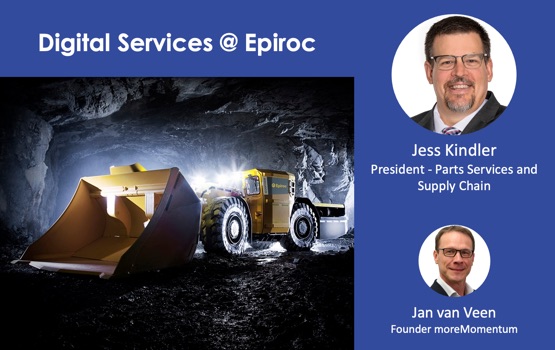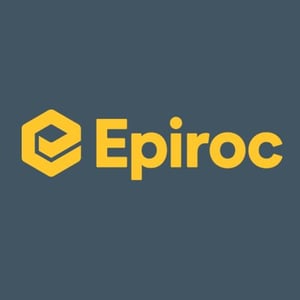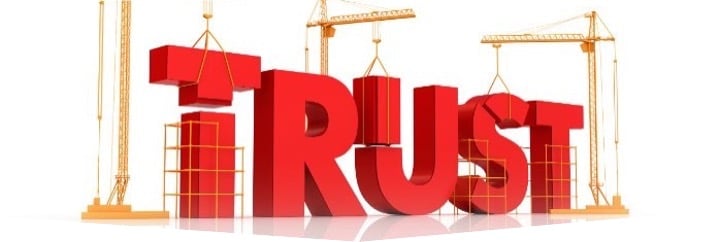Building Trusted Partnerships in the Digital and Remote Era
In the digital-first service era, embracing digitalization, redefining customer touchpoints and advancing service models for partnerships are...

With today’s disruption from Covid and the economic downturn, continuing services innovation is paramount to survive and thrive. Customer needs are changing, and new competition is entering your industry. Some of the critical success factors are service R&D, service product management and sensitivity analysis.
Jess Kindler (Epiroc) and Jan van Veen (moreMomentum) discuss the development of Digital Services at Epiroc.
It is easier said than done:
It is essential for all of us to get this right.
From previous crises, we have learned that the discrepancy between leading innovators and stagnating laggards increases during and after a crisis. These are the moments for market disruption, with new winners and losers.
Recently, I had an exciting conversation with Jess Kindler of Epiroc, a worldwide provider of solutions for the mining and infrastructure industries (more about Epiroc and Jess at the end of this article). We discussed how to maintain momentum with service innovation and thrive during a disruption.
We’ve covered several important topics:
Jan van Veen: We see an acceleration of adoption of digital technology in all industries, which has a major impact on how your clients work. How is this affecting your industry?
We see a continued demand and push for autonomous solutions – equipment that doesn’t have an operator. You need a control room, communications infrastructure, change management and everything else that goes along with transitioning from operator-run machines to control room or computer-run machines.
Of course, this has a significant demand on the service team to commission and look after those autonomous solutions. Coming into the crisis, we knew more or less what our capacity was, and we were still building our capacity. And now it looks like we’re really under capacity because I think even more demand now comes for autonomous solutions.
What do we do then to speed up? We have pretty aggressive training plans in place to grow people, organically, but it’s not fast enough. That leads us to acquisitions and evaluating what’s going to be available now as this crisis develops and unfolds. End state being, we want more capacity to deliver to our customers.
Jan van Veen: Do you also see your value proposition moving from “providing equipment” to “providing an integrated solution” where the value is about an efficient process for your clients? And do you have the technology, data and capabilities to optimise the ongoing operations of your clients continually?
There’s a significant portion of the service business that is no longer related to the mechanical function of the machine but to immediately seeing what’s going on underground. It’s more related to the digital enablement and the infrastructure on the site, like operator pods, Wi-Fi networks and good, high quality, high definition, low latency video solutions. There is a whole chunk of services that we were not used to providing in the past. We have learned over time, let’s say five years, how to handle that in a better way.
Two shifts that I see.
One shift is around overall optimisation of the mine site – optimising the operation of equipment and the use of available hours of the equipment. This requires more data and tracking underground to know which machines are sitting where, and why they are sitting there.
And then the other big shift is around reliability. Reliability is about minimising all the unplanned downtime, stretching the length of time between planned stops and sweating the assets in a better way. This involves aspects like:
So two different kind of activities are happening now, in a bigger way than they were in the past.
Jan van Veen: This requires serious service innovation, developing your offerings and capabilities. One of the common challenges for manufacturers is to develop viable services for commercial success.
A big thing for me is that it’s okay to experiment. But at the end of the day, we also need to make money. When we started this Service Division 8 years ago, we learned that you have to establish service products. You have to take service offerings and turn them into products. These have to be managed by a product manager that understands commercially how to monetise this service offering.
The last thing you want is having highly skilled, highly competent, highly trained people and giving your services away for free. So that’s why it’s essential to have a product behind all these activities.
For example, when it comes to reliability, we established a new product called Total Cost of Ownership. The name says we want customers to experience the lowest total cost of ownership on our equipment. That comes from stretching maintenance intervals and doing reliability analysis.
And when it comes to the overall optimisation of the use of the equipment, then that’s a different agreement type, and it’s more of a consulting arrangement and comes more into our telematics product line.
If you don’t make it a product, then you live and die by the day rates or the hourly rates of your technicians. But if you establish services as a product you guarantee a certain amount of utilisation of your service technicians.
Jan van Veen: Let’s say you have to write a brochure for your service. You don’t want to say, “we have the best-trained engineers, and we have these tools”, because these are all features. Your clients don’t care about features but want to understand the value they will get. What problem are you solving for your clients? What is the result they will get? For example: “we typically see a productivity improvement of x%, and these are the engagement rules, the processes and how we interact with each other”. Once that value is clear, your price will be considered fair too.
We learned earlier on what the benefits of an autonomous fleet are regarding productivity compared to a non-autonomous fleet. This is our main value proposition to the customer, whether it’s a 20% improvement in productivity or 15% improvement on the maintenance cost or a reduction on breakdowns. It’s all about speaking to that instead of arguing about the hourly fee for a technician.
Jan van Veen: Today, on the one hand, business and innovation are under pressure and on the other hand, we see several trends accelerating. How do you manage the uncertainty when deciding on your innovation portfolio?
Often, product managers skew to the optimistic scenario. That is why it is essential to run a sensitivity analysis: if the business goes away by 50%, is this product still viable? If the business goes up 50%, do we have the capacity in the supply chain to deliver it?
Mining companies plan on a 20-year horizon. In those 20 years, everything can happen. Commodity’s prices can go up, they can go down, wars can happen, depressions, recessions, expansions, all those things can happen. When you go to invest your money into a project, it’s important to know what the chances are that you’re going to be profitable. We have learned to use sensitivity analyses for this.
Everybody can write a model that shows a positive NPV (net present value). You can just play with the cells in Excel until it pops out positive, but that’s not what we are after.
Jan van Veen: I think many business leaders and service leaders do too little of this sensitivity analysis. This is one of the capabilities which will enable them to defend innovation in these uncertain times and also do it right.
Service leaders must have some R&D function. I think, with many businesses like ours, it was always the capital guys keeping all the R&D on their side. But we learned a couple of years ago, when it comes to eliminating the single-source dependency on suppliers, and designing out costs in the machine, it’s vital that the service group has some R&D capabilities as well.
Usually, on capital equipment, you have R&D being driven by the marketing guys. On our side, on the service side, we have R&D being driven by the sourcing team. When the sourcing team has problem suppliers or just structural issues where they can’t get the cost any lower, they engage the R&D team to design two or three solutions to get more competition for our spend.
It’s important to defend that to your board and to the group. You must have innovation in the service group instead of using resources at the capital division or somewhere else.
Service Leaders Must Have a R&D Function
Jan van Veen: One of the things I’ve learned is that if you want to defend something, or convince somebody or engage people, don’t sell the solution first. First, sell the problem or what is at stake. And ideally, this is a bigger game than just the solution you are aiming for.
What is the bigger game round getting service innovation on the agenda? What is at stake? Why should a CEO bother?
I try to paint my stakeholders a picture. So I give them some real poignant examples of success and failures. I tell that story, and then I tie it into what the landscape looks like today. Where are the chances that we can either have great strategic success or failure if we’re not careful?
I paint them a picture of projects that are happening right now. And then reinforce the reasons why it’s important to protect investments in these innovations or the acquisition.
That is another point; a growth strategy has to contain both organic growth (innovation) and inorganically (acquisition). So if I can paint a poignant enough and vivid enough picture of what it looks like out there, then when I come with some acquisitions, I point back to that story that I told them and say, “Hey, remember I showed you guys this picture, and this is where that acquisition fits.”
Jan van Veen: We talked about new solutions, new value propositions and new capabilities for mining companies. What you typically see when your clients change the way they run and manage their assets and their operations, is that they are becoming more data-driven. They are developing their digital and data capabilities. They will use more and more services of system integrators and digital native service providers.
Potentially, you run the risk that these other service providers become the partner of choice for your clients to optimise and manage the whole operation, including the assets. I can imagine that the real market disruption here could be manufacturers being pushed down in the food chain. Manufacturers may deliver the spare parts and the equipment only. Is that a fair picture?
That’s a completely fair picture. We have a big focus on making sure this doesn’t happen. We know who’s innovating around our equipment, we go for partnerships, we go for acquisitions, and we go for organic solutions in that space. We know that the longer-term game is around productivity and overall optimisation of the equipment. So, there’s all kind of things that we’re doing to make sure that we stay on top of it.
Jan van Veen: Is it also a matter of changing the attitude of your entire company? What is really your core business and value proposition? Are you a manufacturer of great equipment or………..?
Our VP of Marketing for Services is the Head of the Marketing Council for the group. They have been driving this discussion for two years now. Really getting everybody to understand what our value is. Why do customers want to buy from us? And how do we want that going forward? So yes, absolutely, those discussions are happening. And it’s important.
Jan van Veen: What kind of questions do you raise in that kind of discussions? How do you open new perspectives? You have to ask the right questions and get the right insight from the outside-in to trigger those thoughts.
I think it is around understanding what is winning us tenders today and what is going to win us tenders going forward.
It’s a generational shift over the last 20-year horizon. Over the last 20 years is has been less about relationship sales and more and more about productivity sales and the counsellor sales approach or the consultative sales approach. So that’s a big change for all marketing guys.
A few takeaways are:
Now, my question would be: What will drive the success of your company as a whole as you industry evolves?
I hope this was useful to you. 
Epiroc is a worldwide provider of innovative equipment, consumables and service for the mining and infrastructure industries. It used to be part of Atlas Copco and has been separated since around mid-2018. It consists of five divisions which are Surface, Underground, both offering equipment like drilling tunnelling, loaders, mine trucks and ventilation systems and what have you. Then thirdly, the Technology and Digital Division, which drives the automation, digitisation, and interoperability expansion for Epiroc, including consulting and engineering services. And then we also have Tools & Attachments, which offers all kinds of rock drilling tools and hydraulic attachment tools and related services. And finally, we have the Parts & Services Division, which is being headed by Jess.
A few facts and figures:

Jess is president of the Parts and Services Division, which provides a complete range of services with the aim of maximising customers’ productivity. The division focuses on spare parts supply, professional services, support solutions and training.
Jess has been with the service business of Epiroc for about 20 years now.
Subscribe for the our Impulse Letter
With regular updates about service news, trends and best practices.

In the digital-first service era, embracing digitalization, redefining customer touchpoints and advancing service models for partnerships are...

Manufacturing companies have a tremendous opportunity to grow and thrive through digital services if they escape from business-as-usual. For most...

Navigating data-driven service transformation requires overcoming key challenges such as securing stakeholder buy-in, matching services with market...